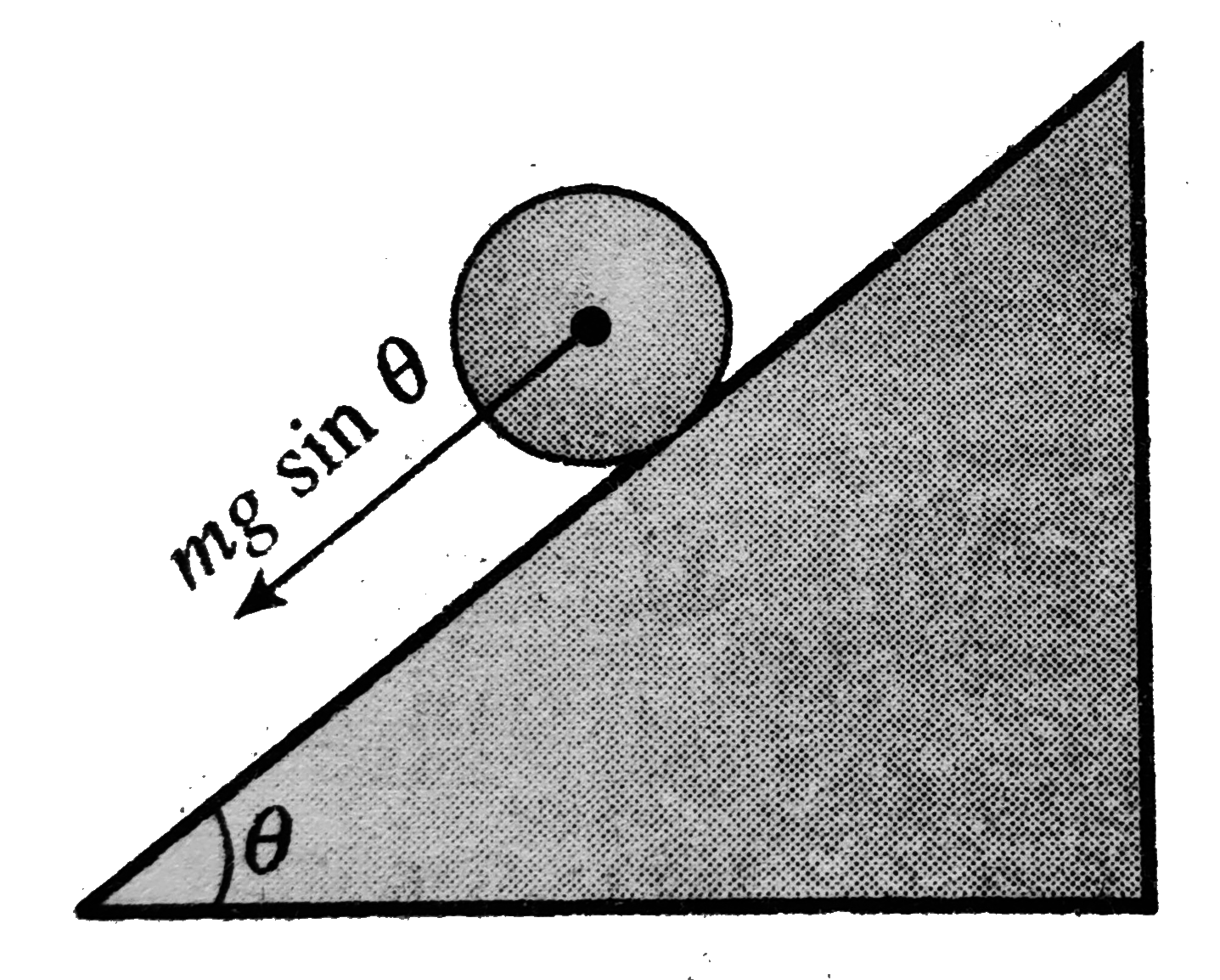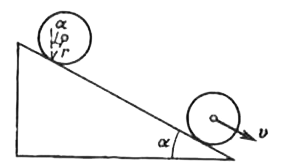A cylinder of mass 2 kg is released from rest from the top of an inclined plane of inclination 30∘ and length 1m. If the cylinder rolls without slipping, then its speed when it reaches the bottom, is [Take, g = 10 m/s2]
203 m/s
√203 m/s
103 m/s
√103 m/s
The correct Answer is:A
To solve the problem, we will use the principle of conservation of energy. The potential energy lost by the cylinder as it rolls down the incline will be converted into kinetic energy (both translational and rotational).
1. Identify the parameters:
- Mass of the cylinder, m=2kg
- Length of the incline, L=1m
- Angle of inclination, θ=30∘
- Acceleration due to gravity, g=10m/s2
2. Calculate the height (h):
The height h can be calculated using the sine of the angle:
h=Lsin(θ)=1⋅sin(30∘)=1⋅12=0.5m
3. Calculate the potential energy (PE) at the top:
The potential energy at the top of the incline is given by:
PE=mgh=2⋅10⋅0.5=10J
4. Set up the kinetic energy (KE) at the bottom:
When the cylinder reaches the bottom, its energy will be in the form of translational kinetic energy and rotational kinetic energy:
KE=KEtranslational+KErotational=12mv2+12Iω2
For a solid cylinder, the moment of inertia I is:
I=12mr2
The relationship between linear velocity v and angular velocity ω is:
ω=vr
5. Substituting the moment of inertia:
Substituting I and ω into the kinetic energy equation:
KE=12mv2+12(12mr2)(vr)2
This simplifies to:
KE=12mv2+14mv2=34mv2
6. Using conservation of energy:
Setting the potential energy equal to the total kinetic energy:
mgh=34mv2
Canceling m from both sides (since m≠0):
gh=34v2
7. Substituting values:
Substituting g=10m/s2 and h=0.5m:
10⋅0.5=34v2
Simplifying gives:
5=34v2
8. Solving for v2:
Multiplying both sides by 43:
v2=4⋅53=203
9. Finding v:
Taking the square root:
v=√203≈2.58m/s
Final Answer:
The speed of the cylinder when it reaches the bottom of the incline is approximately 2.58m/s.
---
- Mass of the cylinder, m=2kg
- Length of the incline, L=1m
- Angle of inclination, θ=30∘
- Acceleration due to gravity, g=10m/s2
The height h can be calculated using the sine of the angle:
h=Lsin(θ)=1⋅sin(30∘)=1⋅12=0.5m
The potential energy at the top of the incline is given by:
PE=mgh=2⋅10⋅0.5=10J
When the cylinder reaches the bottom, its energy will be in the form of translational kinetic energy and rotational kinetic energy:
KE=KEtranslational+KErotational=12mv2+12Iω2
For a solid cylinder, the moment of inertia I is:
I=12mr2
The relationship between linear velocity v and angular velocity ω is:
ω=vr
Substituting I and ω into the kinetic energy equation:
KE=12mv2+12(12mr2)(vr)2
This simplifies to:
KE=12mv2+14mv2=34mv2
Setting the potential energy equal to the total kinetic energy:
mgh=34mv2
Canceling m from both sides (since m≠0):
gh=34v2
Substituting g=10m/s2 and h=0.5m:
10⋅0.5=34v2
Simplifying gives:
5=34v2
Multiplying both sides by 43:
v2=4⋅53=203
Taking the square root:
v=√203≈2.58m/s
The speed of the cylinder when it reaches the bottom of the incline is approximately 2.58m/s.
Topper's Solved these Questions
Similar Questions
A cylinder is released from rest from the top of an incline of inclination θ and length. If the cylinder rolls without slipping. What will be its speed whenit reaches the bottom?
View SolutionA hollow sphere is released from the top of an inclined plane of inclination θ and length L. If a hollow sphere rolls without slipping, what will be its speed when it reaches the bottom?
View Solution
Knowledge Check
A cylinder is released from rest from the top of an incline of inclination θ and length l. If the cylinder roles without slipping, its speed at the bottom
A√4glsinθ3B√3glsinθ2C√4gl3sinθD√4gsinθ3lAn object of mass m is released from rest from the top of a smooth inclined plane of height h. Its speed at the bottom of the plane is proportional to
Am0BmCm2Dm−1A solid cylinder of mass 3kg is placed on a rough inclined plane of inclination 30∘. If g=10ms2, then the minimum frictional force required for it to roll without slipping down the plane is
 A2NB5NC15ND18N
A2NB5NC15ND18N
A hollow sphere is released from top of an inclined plane of inclination 30° and length of inclined plane is I. If sphere rolls without slipping then its speed at bottom is
View SolutionA hollow sphere is released from top of an inclined plane of inclination 30º and length of inclined plane is L. If sphere rolls without slipping then its speed at bottom is
View SolutionA solid cylinder with base radius jis placed on top of an inclined plane of length land slope angle α (Fig). The cylinder rolls down without slipping. Find the speed of the centre of mass of the cylinder at the bottom of the plane, if the coefficient of rolling friction is k. Can rolling friction be neglected? Do the calculation for the following conditions: l=1m,α=30∘,r=10cm,k=5×10−4m . What would be the speed if, in the absence of friction, the cylinder slides down?

View SolutionA hollow cylinder and a solid cylinder having the same mass and diameter are released from rest simultaneously from the top of an inclined plane. They roll without slipping which will reach the bottom firstly
View SolutionA block of mass m is released from the top of a mooth inclined plane of height h its speed at the bottom of the plane is proportion to
View Solution
